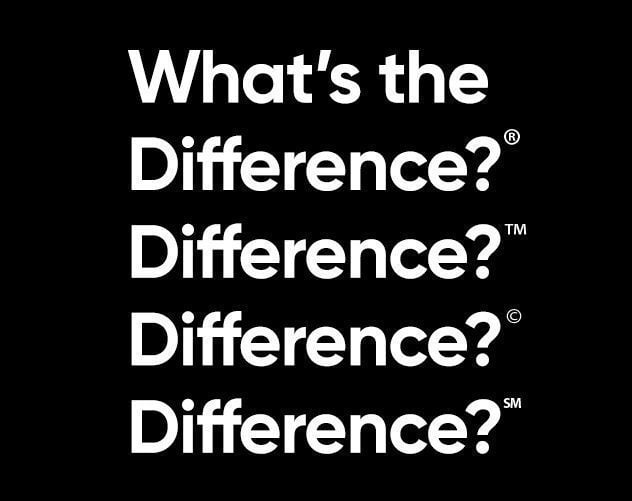Trademarks & Copyrights and Registered Trademarks
If there’s a group of legal terms we often say as if they’re interchangeable, those words are trademark, copyright, and registered trademark. All are similar, but have very distinct meanings. It’s important to know the difference, especially since these are different legal terms that provide different legal coverages. Here are the basics of what you need to know:
COPYRIGHT ©
Copyrights are denoted by the icon ©. Copyrights date back to the late 1700s, with the first federal copyright act instituted in the US Constitution in 1790! Copyrights cover publications/literature, art, music, drama, or intellectual property. Publication of such work, or registration with the US Copyright Office, are not required, but it certainly helps to fulfill those actions to get better legal coverage incase of infringement. Copyrights can be registered online.
Copyrights do not cover company names, product names, brand identity (logos, slogans, designs, etc.).
There are a few foundational rights under copyright law:
- The copyright holder has exclusive rights to print, display distribute and perform the work. This includes publishing and transmitting the work on the Internet.
- The work must be original.
- The work must be available in some sort of fixed/tangible form, like a book, video/sound recording, etc.
- The work lasts the duration of the life of the creator, plus an additional 70 years (if copyright involves a group of people, it lasts 70 years after the last surviving author/creator’s death).
TRADEMARK ™
Trademarks are denoted by the icon ™. They are used for brand identity items such as logos, designs, slogans, etc. The reason this legal term came about was to help protect and distinguish the goods of manufacturers/sellers, and even consumers. The only catch is, regular trademarks aren’t registered with the USPTO, which does not guarantee complete legal coverage. For instance, if one company trademarks their slogan, but another company uses the same one, the companies would have to prove who produced the slogan first. Even then, if neither company is registered, there is no guarantee of legal defense. This is why it is important to go all in and acquire a registered trademark.
SERVICE MARK ℠
Service marks are denoted by the icon ℠. These are essentially the same as trademarks, but are used to distinguish services, rather than goods. Like trademarks, they do not have any special legal coverages.
REGISTERED TRADEMARK ®
Registered trademarks are denoted by the icon ®. If you haven’t guessed, these are trademarks that have been registered and verified/approved by the USPTO, and have full legal coverage. Registering proves your trademark is original, legitimized by the federal government, and can’t be infringed by another person or company.
The registration process can be tedious, but it is well worth it to keep your brand unique and unusable by anyone else. First, you must check that your name or logo is not already a registered original trademark, which you can check on the USPTO site’s database. Once you send in an application, it can take months to get a response. If approved, the registration lasts 10 years, but must go through a verification process between years five and six in order to validate that the trademark is still in use.
Fun Fact! Copyrights and Trademarks are managed by two federal government offices – the U.S. Patent and Trademark Office (USPTO) specializes in trademarks, whereas the U.S. Copyright Office oversees all copyrights. That’s how different the two are, legally.
So, which icons should you include in a logo?
It’s not required, but you should definitely include ®. Utilizing the registered trademark lets the world know your idea can’t be stolen, and legally protects you from infringement.
You can include ™ or ℠ , but they’re not required. Again, neither of these symbols legally protect you, or at least give you anymore protection than you already have under common law. It’s all a matter of opinion – if it’s going to distract from your logo, you may not decide to use it. But those symbols also suggest the brand is legitimate, so if you have room for it, then go for it!
Often times, any of these symbols can be found in the bottom right corner of the logo, but if a designer needs to put the icon somewhere else in the logo, there are no regulations for icon placement on logos. If you’re building a new brand and getting help from a designer, make sure to let them know if you plan on utilizing one of these icons in the logo, so they can be aware while they’re designing the logo.
When all is said and done, it’s always best to discuss these items with a lawyer before proceeding. However, this information can help get you started and have a solid idea of the difference between these icons, what protections they offer (or do not offer), and how to proceed with a logo design.
Helpful Resources:
Check this article for more detailed information and a video on trademarks, patents, and copyrights from USPTO:
https://www.uspto.gov/trademarks-getting-started/trademark-basics/trademark-patent-or-copyright
To read into full detail of the copyright law of the United States, you can access the full law at the following link:
https://www.copyright.gov/title17/
At Prizum Creative, we always try to explain the importance of registering your new brand with the USPTO. If you’re starting a new brand and have questions, or need design solutions to get your brand started, contact us today.
This blog was not written by a lawyer. Please see an attorney for official legal advice. Prizum Creative is a team of artists trying to help other artists and clients gain a better understanding of these industry terms. See government resources listed above, or contact a lawyer for advice/information.





